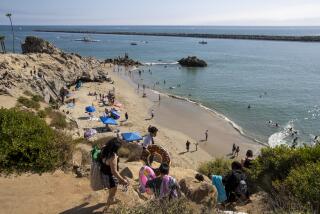Ormond Wildlife Could Be Selling Point, Panel Says
OXNARD — A group of experts has unveiled an environmentally friendly plan to build at Ormond Beach, possibly paving the way to end a decade of contention over Ventura County’s largest remaining tract of undeveloped coastline.
A panel of nine trouble-shooters from the Washington, D.C.-based Urban Land Institute concluded that preservation of 300 acres of wetlands along the beach must be at the core of future development plans.
Dunes, a lagoon and marsh provide important habitat to wildlife, including the imperiled California least tern and western snowy plover, pressed hard by surrounding industrial and agricultural development.
“The property has to be cleaned up as much as possible and the first step is to clean the wetlands and bird habitat and maximize that,” said James Pollak, a Montana-based specialist in corporate and real estate finance who chaired the panel. “By making it attractive, you enhance the value of the property around it. It is an important element.”
Stymied and frustrated by previous failed proposals, officials from Oxnard and the Metropolitan Water District spent $105,000 to bring in experts from the nonprofit institute, which specializes in solving complex land-use disputes.
After months of briefings, the panelists spent last week in Oxnard sorting out goals for the 1,404-acre Ormond Beach area, one of the oldest and poorest areas of the county, and devising ways to turn it into an economic engine. The panel presented its findings to the Oxnard City Council on Friday and will fold them into a final report by September.
Ormond Beach is a study in contradictions. Wedged between the Pacific and crops on the fertile Oxnard Plain, all manner of development can be found around Ormond Beach, including a sewage plant, a naval base, a foundry, farms, a major port, a power plant and a paper mill. Finding a development plan to satisfy all concerns has proven virtually impossible.
To lure new businesses, the area has to be managed to emphasize its amenities, like the beach and wetlands, and get rid of activities that sully it, such as the 35-year-old Halaco Inc. aluminum recycling plant, which Pollak says has compromised the area with noxious fumes and unsightly slag heaps.
The wildlife habitat should be enhanced with cleanup and a steady flow of clean water, instead of the industrial storm drain now feeding it. It should also be placed into a conservatorship to ensure its long-term protection.
In addition, Halaco should be bought out and closed and the slag heaps turned into rolling hummocks covered in soil, grass, trees and walking paths to create an open-space buffer. Both moves are seen as essential to attracting business, Pollak said.
“It’s a complete reversal of the traditional view of Ormond Beach, which has been to figure out what to do with development, then do whatever you can do with the wetlands,” said Steven L. Kinney, president of the Greater Oxnard Economic Development Corp. “This is saying that the wetlands and environmental features are the primary marketing assets of the area, and you’re not going to be able to attract desirable development until those assets shine to their fullest extent.”
For the rest of the area, the panel recommends building about 2,400 homes on about 400 acres of farmland straddling Hueneme Road outside of an area designated by the Navy as a jet aircraft noise zone. The houses would be flanked on the east by golf courses, parks and open space along Arnold Road.
Rice Road should be extended to the center of Ormond Beach and industrial properties there should be augmented over the next decade or so. The name of the road should be changed to Ormond Beach Road and link the area to the Ventura Freeway five miles away, the panel recommended.
So far, the proposals are earning positive reviews from stakeholders.
“It’s a very good plan. I think this will jump-start that area and [help people] realize what a gem it is,” said Jean Harris of the Ormond Beach Observers.
Michael Plisky, a commissioner for the Oxnard Harbor District which manages Port Hueneme, said the development plan can serve as a blueprint to protect the environment and promote growth in the county.
But the proposals, which attempt to find compromises among competing interests, have also drawn criticism.
Harris said she opposes the location of some of the houses that would be built at Ormond Beach. And a spokesperson for the Naval Air Station and Point Mugu said nearby development could be problematic for the base.
Pollak, the panel chairman, said the panel can only come up with recommendations and that it is up to local leaders to act.
“People need to subordinate their interest and support the common good,” Pollak said. “If you don’t do that, you can get the best panel of experts in the word and no one is going to do anything. We are land use people; we are not psychiatrists.”
Oxnard City Councilman Thomas Holden said in the next few months the council will likely take steps to turn the proposals into a specific plan for developing Ormond Beach.
He said the city will probably hire an Ormond Beach project manager, establish a committee to move the proposals off the drawing board, begin looking for a way to place the wetlands under government or private protection and identify options to close Halaco.
“These proposals just make sense and we intend to move forward,” Holden said.
More to Read
Sign up for Essential California
The most important California stories and recommendations in your inbox every morning.
You may occasionally receive promotional content from the Los Angeles Times.










